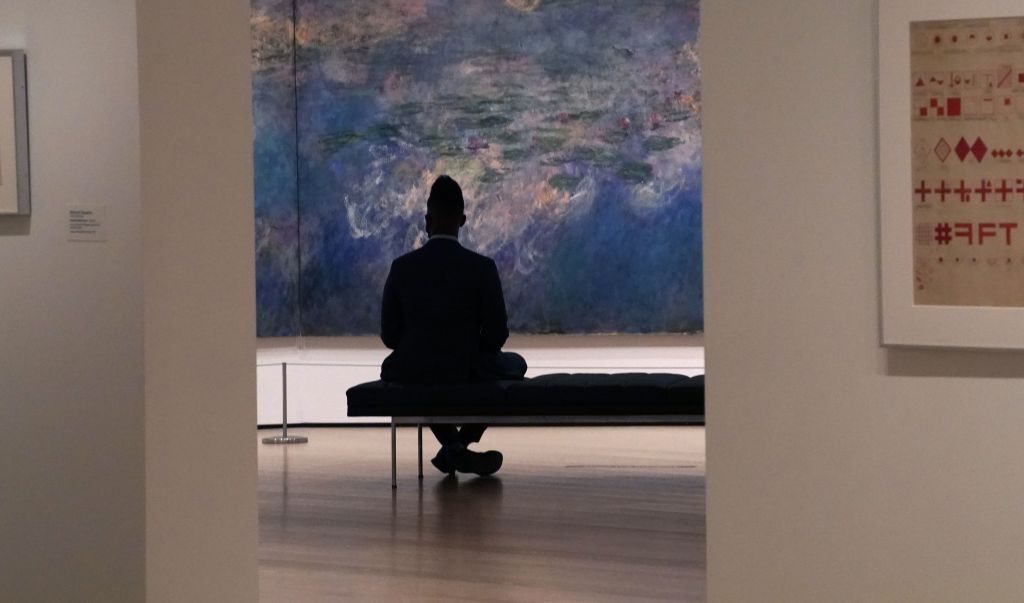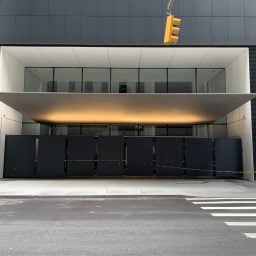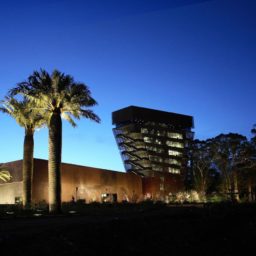On August 27, three days after getting the green light from New York State, the Museum of Modern Art reopened to the public, with mandatory reservations, limited capacity, and new safety protocols in place. But museum staff has already been back for weeks: unlike many other art institutions across the city, MoMA required that all employees resume working on site in staggered shifts beginning July 6, the same day the city entered phase three of its reopening.
“The heart of the museum’s mission is being accessible to the public,” reads a message to staff on MoMA’s Returning to the Workplace webpage. “This requires us to reactivate our building, and be physically present to interact with our visitors, space, and collection.”
In order to keep working exclusively from home, staff members had to provide documentation demonstrating insurmountable childcare challenges or medical conditions that put them at an increased risk from the virus—and were required to reapply for these exemptions ahead of Labor Day.
That decision has proven controversial among some staff members, who contend that the institution’s response to the pandemic and its approach to reopening are intrinsically linked to problems that have come under the microscope across the museum sector in recent months: structural racism and inequitable treatment of workers.
“We’re here to serve the public and we want to be available to people, but the entire return to work policy has been framed in a really punitive way, and not taking into account the real concerns about the virus,” one staff member, who asked to remain anonymous, told Artnet News.
“It almost feels like there are more staff here right now than there are visitors,” another worker, also speaking anonymously, told Artnet News. “There is not much actual reason for us to be at the museum right now.”
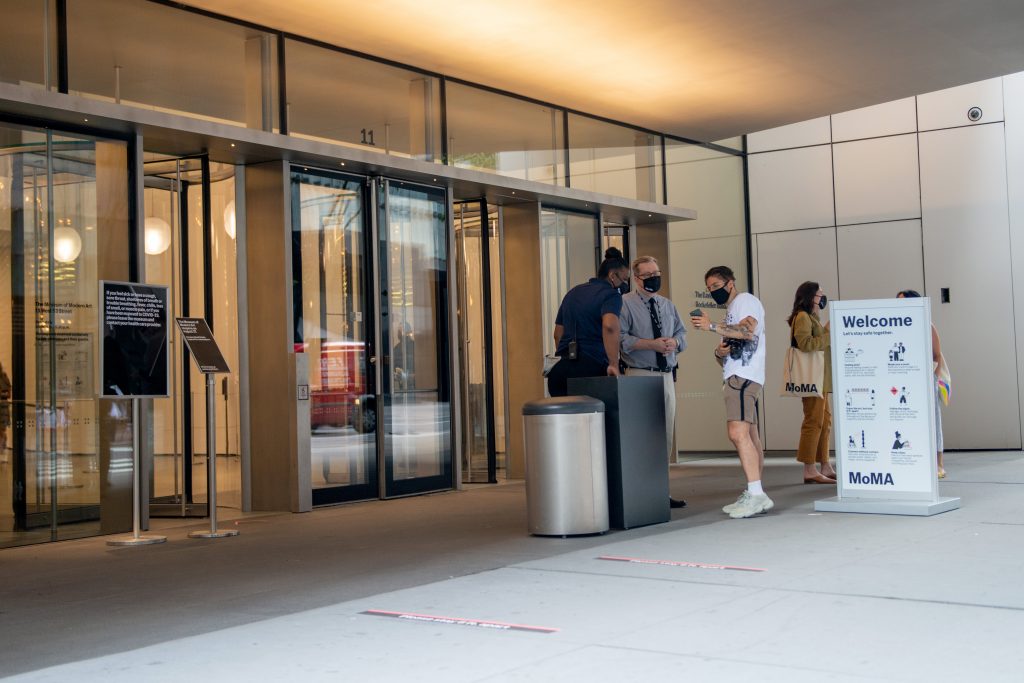
A masked visitor shows his ticket to employees at the newly reopened Museum of Modern Art in New York City. Photo by Alexi Rosenfeld/Getty Images.
A Time of Reckoning
In the wake of the murder of George Floyd and the ensuing Black Lives Matter protests that spread across the country this summer, many museums have faced calls to look inward and to address issues of racial discrimination. At the same time, the ongoing push toward unionization within the field, coupled with widespread layoffs and furloughs in an increasingly cash-strapped sector, has raised new concerns about how institutions treat their staffs.
To date, MoMA has avoided making headlines like the Metropolitan Museum of Art and the Guggenheim Museum, both of which unveiled new equity and diversity plans in the face of public criticism.
But behind closed doors, similar concerns have been raised at MoMA. On June 11, the museum’s education department sent a letter to senior leadership and the president of the board of trustees outlining 11 concrete steps the museum should take to combat structural racism, including the formation of a cross-departmental Diversity, Equity, Accessibility, and Inclusion task force.
In an all-staff email on June 22, MoMA director Glenn Lowry announced that he had formed a steering committee made up of BIPOC staff from across departments. A museum representative told Artnet News that the committee was formed “in response to a museum-wide commitment to prioritize anti-racism in all aspects of our work” and has “a combined tenure of 68 years experience at MoMA.”
The education department had also asked that its letter be shared with the entire MoMA staff, which it was not. As staff returned to work on site on July 6, a larger group of employees—229 staff members across 30 departments—sent a follow-up email to the full workforce expressing concern with the reopening procedures and what they saw as the museum’s lack of action regarding anti-racism efforts.
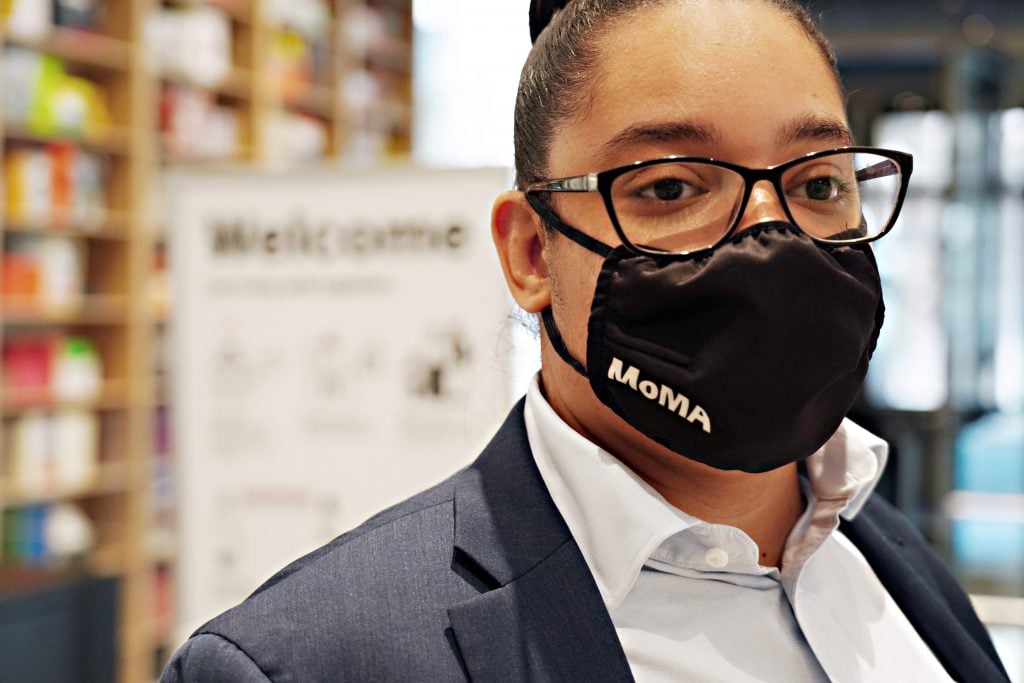
The Museum of Modern Art has provided its staff with MoMA branded protective masks as the city continues Phase 4 of re-opening following restrictions imposed to slow the spread of coronavirus. Photo by Cindy Ord/Getty Images.
“The current plan, though framed in the name of equity, does not adequately consider the disproportionate impact that COVID-19 has on the health, safety, and well-being of Black frontline staff and communities of color living in an already inequitable system of white supremacy,” the letter stated. “Black frontline, non-management staff members have not been meaningfully involved in MoMA’s decision-making around the pandemic, despite the fact that many of these staff members have continued to physically work at the museum since March.”
The museum, meanwhile, has suggested it has gone above and beyond to ensure the safety of workers. To help devise safe reopening procedures, it hired Bernard Camins, the director for infection prevention for the Mount Sinai Health System, as a consultant.
Under Camins’s guidance, MoMA “implemented staff health questionnaires, temperature checks, PPE and social distancing requirements and new health and safety workflows, configurations of the workspaces, and protocols in the galleries,” a museum rep said.
MoMA also co-led the city museums reopening task force, a coalition of top museums including the Metropolitan Museum of Art and the Whitney that formed to develop uniform safety measures. But unlike MoMA, many of its peer institutions, including the Guggenheim and the Brooklyn Museum, are instructing office workers to continue doing their jobs remotely where possible.

A woman walks through a temperature scanner at the entrance of the Museum of Modern Art. Photo by Timothy A. Clary/AFP via Getty Images.
Equity vs. Equality
MoMA is operating with office staff at just 50 percent capacity (all employees rotate in and out), but, sources contend, different employees face vastly different degrees of risk. Some workers live close enough to walk or bike (Lowry lives in an on-campus apartment provided as part of his compensation), but others have hour-long subway commutes that greatly increase their potential exposure to the virus. And those disparities don’t go away once workers set foot in the museum.
“Senior leaders can go into their office and close their doors and not see anyone for the rest of the day,” said the first MoMA employee. “People on the front lines have to interact with the public.”
In what some staff described as a heated Zoom staff meeting on June 29, Lowry insisted that having all staff on site was a matter of solidarity. “The idea that some of us can work at home because what? We’re better educated? We’re white? We’re privileged? You make up the reason why we think we can work at home, but others of us actually have to be at work,” he said in a recording obtained by Artnet News. “That’s not the institution I want to be part of. I think we’re all in it together.”
“While some of us might be able to argue we never have to be in the museum to still do our work, that’s not equity—that’s the opposite of equity,” Lowry added. “To suggest somehow that one population can be at risk, and another population shouldn’t be at risk to make it less risky for the population that’s at risk, is absolutely crazy.”
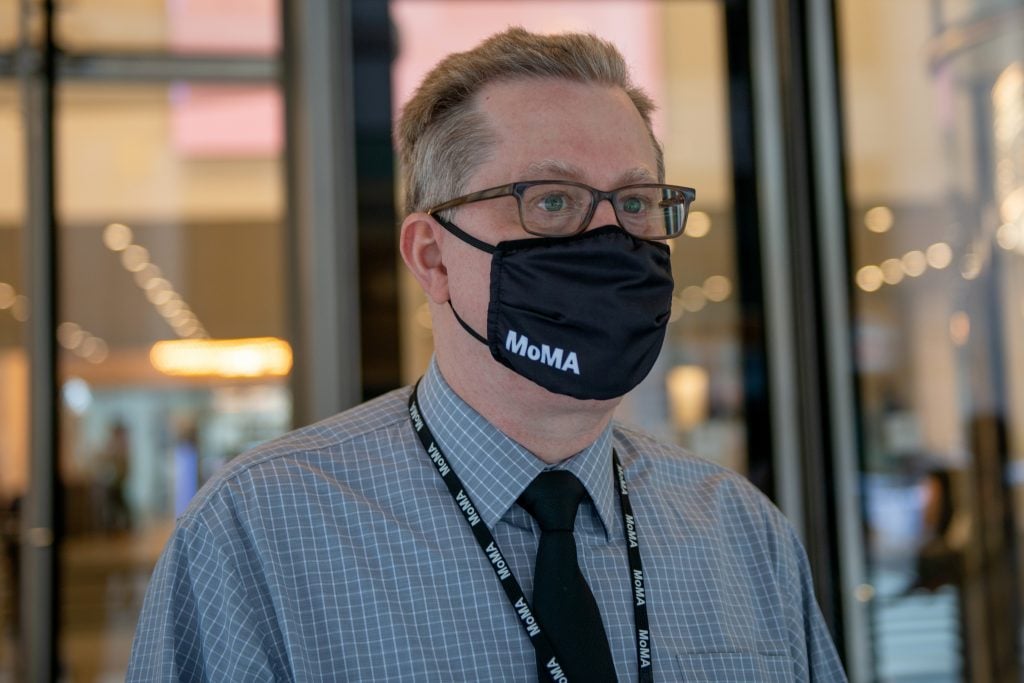
An employee wearing a MoMa mask at the newly reopened Museum of Modern Art in New York City. Photo by Alexi Rosenfeld/Getty Images.
Some employees felt Lowry’s attitude skirted the real dangers posed by MoMA’s approach. “Equity is looking at how we are all affected differently and trying to find a solution that gives us all the same opportunities for better outcomes—as opposed to equality, which gives us the same solution, but where our outcomes are still affected by our context,” a third MoMA staffer said. “As a Black staff member, I’m extremely aware of how my community has been impacted by COVID.”
The third employee recalled a recent virtual all-hands meeting that offered a stark example of the divisions within the staff. “There was this really laughable moment when we were asked to applaud for all the security officers and none of them were on the call—like one person from security was on the call!” the employee said. “The health and safety discourse can’t be divorced from the lack of movement on race and racism at the museum—they are totally bound up with each other.”
As the museum prepared to welcome back the public, it hung a new sign in the lobby listing the names of MoMA’s essential workers, thanking them for their continued work throughout the crisis. To some, the move felt like an empty gesture after the museum stopped offering hazard pay in July. (MoMA did not answer inquiries regarding hazard pay.)
“It starts to feel like this is being done in order to ease the trustees’ anxieties,” the second worker said. “Getting all of us back to the museum gives the board a sense the museum is operational and will at some point go back to being more financially self-sustaining.”

A sign naming and thanking essential workers at the reopened Museum of Modern Art in New York City. Photo courtesy of an anonymous MoMA staff member.
An Unprecedented Squeeze
MoMA has yet to disclose a projected deficit resulting from the closure, but the lockdown has placed unprecedented pressure on its balance sheet. “We all have to recognize that we have to be present, and that at some point the money is going to run out if we can’t get the museum up and running,” Lowry said in the staff Zoom meeting.
Before lockdown, and on the heels of its $400 million renovation, which was unveiled in October 2019 after a four-month closure, MoMA offered an early-retirement program. A spokesperson described it as “a generous offer keeping in mind long-serving senior staff who worked hard to finish the years-long building project… and who might have otherwise taken an earlier voluntary retirement program.” A similar offer was extended after the 2004 expansion; about 40 employees signed on this time around.
Now, with Lowry enacting a $45 million budget cut, down to $135 million from $180 million, sources at the museum tell Artnet News that MoMA has also introduced a voluntary buyout package. The hope is that buyouts, in conjunction with leaving 60 open positions unfilled, will allow MoMA to eliminate 220 positions without layoffs (other than the 85 museum educator contracts terminated in March).
“Like other museums in New York City and across the country, this pandemic and its economic impact is the most serious financial crisis we’ve ever faced,” said MoMA’s spokesperson. “We will continue to look for ways to bring costs down, to maximize revenues, and to push through this fiscal crisis.”
The museum did not offer any comment on the terms of the buyout, but some staff members are not appreciative of the offer.
“People are faced with the possibility of either forcibly losing their jobs or having to take a buyout package,” the first employee said. “Or coming into the office to risk their life, when they could do their work perfectly fine from home.”
